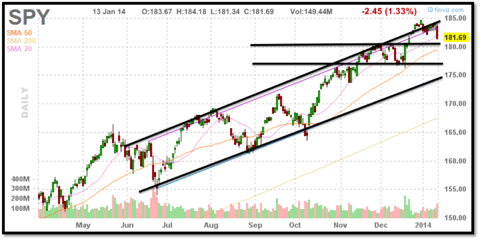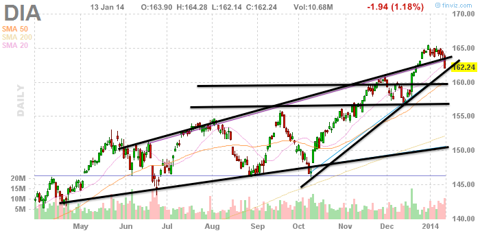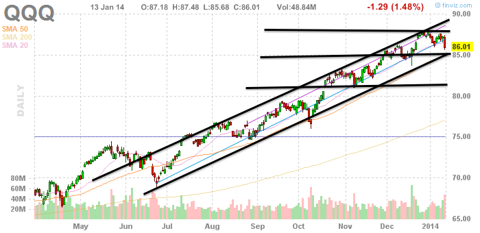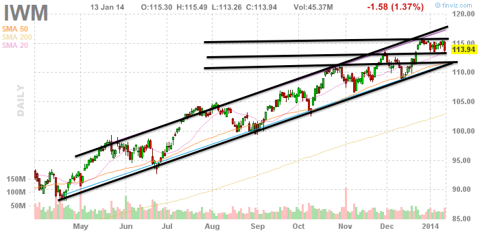Disclosure: I have no positions in any stocks mentioned, and no plans to initiate any positions within the next 72 hours.
Market OverviewThe market got whacked a bit to start the week, but it bounced back nicely on Tuesday on the back of solid retail data and decent enough earnings from JPMorgan (JPM) and Wells Fargo (WFC). On the economic data front, we got news about Retail Sales this morning as well export/import prices. Sales were supposed to come in flat to maybe up 0.1%. Some murmurs were that they would be negative, but they beat all expectations coming in at 0.2%. Export/Import prices both showed slight rises as well. That data is definitely a welcome site and shows at least some better than expected sales during the Holidays.
Today was also the start of earnings season in our view with JPMorgan and Wells Fargo reporting earnings. JPM beat analyst expectations with a 1.30 EPS (1.24 estimates) and $24.1B revenue ($23.9B estimates). Yet, the company was hurt by weakness in their investment bank and mortgage unit. WFC saw a 6% drop in revenue but also beat expectations with 1.00 EPS (0.98) estimate). JPM has been mired by scandals/legal action, but the company was able to see another drop in delinquency. Yet, there is still general weakness in mortgage banking (applications down 50%+ year/year). WFC saw similar results, but they were "optimistic" about 2014.
Company News/Deeper Look
On the company news side, we will be focusing on Tesla Motors (TSLA) today. Since there is a lot to cover, we will also make this our daily "deeper look" as well.
We have been bearish on Tesla since the stock zoomed into triple digits. We started out 2013 being bullish on the company, but we have thought is too rich in valuation at these levels now. In recent articles, we have laid out our bear argument. We first laid out our bear argument on October 25, 2013. In that article, we stressed that international success was necessary to support the company's higher valuations, but we worried about their promise. In our latest article from December, we pushed that argument further.
Main Catalyst
On Tuesday, Tesla stock rallied strongly on several announcements from the company:
- Tesla delivered 6900 vehicles in Q4
- The company anticipates to see Q4 revenue at 20% higher than previous guidance
- Tesla is providing a software update "over the air" to 29,000 vehicle chargers to improve safety even further
These three announcements allowed the stock to soar from in the red to over 10% in gains. What we want to do today is put these numbers into context of the bigger picture and within in our main arguments about being bearish on Tesla. We actually found these numbers to be quite incredible, and they may have been the first signs that are some of our original articles were well…wrong.
First off, we want to reiterate some points we have brought up in previous articles. In our last article, we noted that Tesla would be hard pressed to sell more than 15K-20K of their Model S per year:
YTD through October, the largest volume high luxury car sold in the USA was the BMW 7-Series with just over 9000 units sold. That puts the car on pace for 12K for the year. Even if Tesla can become the top luxury car company in the USA, they would be pressed to sell more than 15-20K of their current lineup and more than 30-40K with some of the new cars they have in the pipeline. Thus, the company needs international sales to reach the 90K level we are looking at for them.In the latest results, the company delivered about 6900 Model S sedans, which would put them on pace for nearly 27,500 Model S sold per year. The most sold large luxury vehicle as of December 2013 was the Mercedes-Benz S-Class at 13K. In the mid-size luxury, the largest seller was the Lexus ES with 72K in sales. Now, the price point for Model S makes it tough for it to ever reach these levels, and the backlog of demand is strong for Model S now. The company is delivering essentially everything they can make. At some point, these levels come down, but we can say its safe to say 20K-25K Model S per year for the next few years is definitely possible. That is an amazing amount of high-end luxury cars to be selling.
The company also has the Model X to debut in the back half of 2014. The price point for this vehicle is expected to be around the same as the Model S, so we are looking at a crossover in the 60K-80K range. Once again, we cannot expect the company to hit the levels of mid-level luxury SUVs that are in the 40K - 60K range, so we have to look at the Mercedes GL at 30K in volumes. That level is around what we believe we can expect for the Model X, potentially as much as 35K in the first couple years. In the best-case scenario, we are looking at 2015 being a year where the company can sell 60K cars domestically.
The Model E or Gen III is expected to release in 2016-2017, and this is the one that matters. When we look at this car in the $40K - $50K range, we can see it selling in the range of 50K-60K per year consistently domestically even up to 80K. Yet, it will be some time before we see it hit the streets. We will say 2017 at the earliest for our model to stay somewhat conservative and given the delays we saw with the Model S.
In reality, we are looking at a 2017 situation where we could see around 120K in domestic sales, and we definitely underestimated in some of our previous models. Let's remove that from the equation for a moment and international growth. With 120K in domestic sales in 2017, we are looking at potential revenue of $7.2B. The company has a goal to have margins like Porsche, which would put them at a 15% operating margin and net margins in the 8-10% range. If the company could execute in this way, that would put net income at 720M in the best case domestically, putting EPS at 5.90 and P/E at 26.4.
We are not high on the international side of things still with charging station issues:
Tesla wants to meet its Supercharger charging station target in Germany by the end of 2014. It's trying to build in a few years what traditional car companies have spent decades doing. This gets to the heart of the short thesis on the automaker's stock. Tesla bears say quarter after quarter that the company is burning through cash too quickly to build the infrastructure it wants, and make the improvements to supply chain that it needs. Bank of America analyst John Lovallo addressed that directly on the company's Q2 conference call, saying: "If we think about cash flow for a minute... free cash flow was a use of about $79 million in the quarter, and I think if you make the adjustments you guys were talking about... $11 million for the DOE payment, a $67 million increase in receivables that may not occur. That looks like the use of about a million dollars. Now, you have cap ex ramping up in the back half of the year so how are you thinking about free cash flow generation through the remainder of the year into 2014?" Tesla CFO Deepak Ahuja could only reply that Tesla "want[s] to be very careful about burning cash...We want to stay as close as we can to a free cash flow position... but that's not something we necessarily want to guide to. We're going to manage it... and spend the cap ex where we need to to ensure we're growing at the right pace."There are a lot of question marks here, so we will use two scenarios. On the low-end, we will assume the company can grow sales internationally to 25K by 2018 and on the high-end put it at 75K. Just so you know, 200K in sales would put the company at the global footprint of Porsche's expected 2014 sales to put things in comparison. Overall, the fact of the matter is that demand is strong domestically for Tesla, and the product is starting to become a household name. With the growing attraction of electric vehicles, tax credits, lack of gas payments, and other benefits, we have to admit we are warming up to the name a bit more.
There is still a ton of speculation, but let's get a bit deeper into pricing the stock.
Pricing/Valuation
Revenue -
In our model, we assume an average price point of $60K (Model S and Model X will be higher, but the addition of the Model E will make up around 25% of sales and have a price point in the $40K - $50K) with operating margin at 15% (this is a best-case margin). In this scenario of 195K models, we can see revenue at $11.7B in 2018. In our worst-case scenario of 125K models, we can see revenue at $7.5B (along the lines of our previous estimates).
Tax Rate -
We assume no taxes in 2014-2015 with up to 20% in 2018.
Margins -
The company has a goal to get to Porsche-level margins, which is around 25% gross margin, 15% operating margin, and 8-10% net margin. That compares to a company like BMW (BMW), who has gross margins at 20%, operating margins at 11%, and net margins at 6-7%. The company hitting these levels would definitely put them at the top of the class. In our best-case model, we will use 15% for operating and 12% in our low-end model.
Other -
CapEx will grow especially with the dedication to building out in Europe and Asia. We see at least $550M in CapEx by 2018 and depreciation growing to around $380M. We use a cap rate of 3%, which is very low discount rate, meaning that the company is a high-growth name with a lot of future income pricing in and needs to be discounted less.
In this new model (195K volume), we come up with a price target of $195. Now, this is the absolute best case of everything happening as we can see it now (outside of Europe). The question mark still remains that as well as execution. In our low-end model, we come up with a price tag of $110 in our model. In our mid-level we are looking at $155 price tag. The difference is obviously that we underestimated sales in the best-case scenario, and that is our main change.
Conclusion
Speculators that believe in this company have an argument for upside at least of 20-30% from these levels, and that can be even higher when one considers Gen III potential. What it comes down for Tesla is execution. The latest results were pretty outstanding and show the company doing well with supply chain, manufacturing, and delivery - something we questioned earlier. This is a good sign for the company. Buyers need to understand, though, that the company has to be perfect to see more upside. If the Model X is not delivered in the 2H of this year, the stock will drop significantly. If Model E does not start to show up in auto shows next year, downside will happen. If international sales do not start to ramp up significantly this year, downside will occur. If the company does all of those very well, though, there is still some upside. We will admit that we have underestimated the company and have been incorrect in our earlier assumptions.
We are still sticking with a conservative approach and using a $155 price tag, but we can understand the argument for higher prices. We are not speculative investors; therefore, we will not recommend shares to our own clients. Those that buy stocks for the future…its very understandable to us now to get behind this name. And yes, we were wrong in some of our earlier assessments. We did not fully appreciate the demand as we are seeing it now.
Charting The Markets
The S&P 500 (SPY) broke out over 1800 but has failed at the 1850 level. We also broke key 1820 support yesterday. Now, we are sitting on key 1800 support where the 50-day MA as well as mental support sits at for the market.
(click to enlarge)

The Dow Jones (DIA) has resistance at 16500 right now with support sitting at 16200 along with 16000. The key support is 16000 since its mental and the 50-day MA. If those lines break, we don't see much support until 15700.
(click to enlarge)

Nasdaq (QQQ) has strong resistance above it and has failed at the 88 area. There is support at 85 and 86 area. The index is very tight right now and should either breakout to the upside over 88 or could retest 85 then potentially move lower.
(click to enlarge)

Russell 2000 (IWM) is in a tight consolidation pattern with 116 resistance and support just below it. If that area fails, we see good support at the 110-111 area. If it can break 116, we do not see much resistance until 118 area.
(click to enlarge)

Wednesday's Outlook
The market got its much needed comeback on Tuesday, and it looks like it could continue if things go well with earnings and data Wednesday. At the same time, we are in a very choppy market right now. As the market moves up and down, it will be very headline-oriented, and we do not expect long trends to develop for a large part of the year at least not the first half. Wednesday, the market will be watching closely for the MBA Mortgage Index, PPI, Empire Manufacturing, and Fed Beige Book reports. The MBA Index is interesting because of recent results showing weak demand for mortgages that could show some housing concerns. Additionally, we will get a key Empire Manufacturing report that is supposed to improve from 1.0 to 3.5 for December. Finally, the Fed Beige Book will be parsed for signs of what it means next for the Reserve. All that comes along with earnings from Bank of America (BAC) Wednesday morning. We are expecting a good report from them as we laid out in our weekly outlook article.
No comments:
Post a Comment